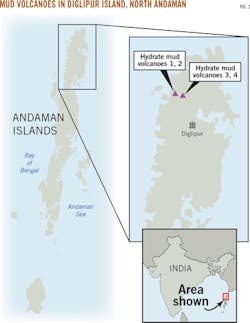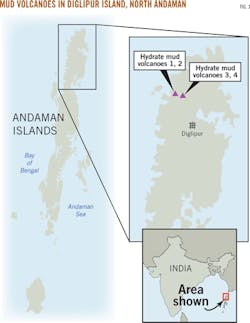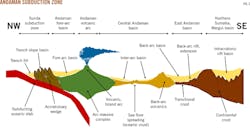Mud volcanoes show gas hydrates potential in India's Andaman Islands
View Image Gallery>>
Vignesh Ayyadurai
Ramanujam Nainar
Chandrakanta Ojha
Pondicherry University
Port Blair, Andaman and
Nicobar Islands, India
Minutes after the M9.0 Sumatra-Andaman earthquake in 2004, mud volcanoes erupted on Diglipur Island in North Andaman. The eruptions resulted in an accumulation of debris that reached above the height of the area's surrounding trees.1
Such activity is linked to hydrocarbons, as discussed in this study about mud volcanoes spread throughout the Hatti level at Diglipur Island (Fig. 1).
Sedimentary volcanism includes mud volcanoes, shale or mud diapirs, and mud lumps. Mud volcanoes range in size from a few centimeters to several kilometers across.
The phenomenon of sedimentary volcanism is usually associated with thick sedimentary overpressured argillaceous sequences, which are found in tectonically active areas such as accretionary complexes. In a tectonic environment, sedimentary volcanism is more common and can be classified in various types known as active tectonics, passive tectonics, and volcanic.
Tectonic activity is the primary force causing the extrusion of mud volcanoes from various depth ranges. Eruptions result when tectonic activity applies pressure on subsurface gas. Sedimentary volcanism not only provides important information about the process of sedimentation at subsurface, but also informs us about deformation at depth. Rapid sedimentation in the Tertiary or Late Cretaceous with its high pore pressure is responsible for many mud volcanoes.2
Overpressure is a primary precondition for the formation of mud volcanoes, but it is not alone responsible for this phenomenon. Mud volcanoes are not common to all overpressured formations.3 4 In addition to overpressure, the availability of muds is another condition.
Mud volcanoes are common in thick clay sequences where pore pressure dissipation is slow due to the low permeability of the material. Overpressure clays occur in different types of environments, such as passive deltaic, active, and compressional regimes. Their composition is marked by several common features:2
• Mostly thick (up to several kilometers), rapidly-deposited, clay sequences.
• Mostly Tertiary in age, but Mesozoic examples exist.
• Almost regressive marine sequences.
• Usually constituted with low-density clays.
• Usually associated with an increase in the temperature gradient.
• Contain salinities that are usually anomalously low.
• Typically associated with hydrocarbons.
• Similar in geophysical properties.
Tectonic evolution
The tectonic evolution of Andaman and Nicobar Islands is modeled on three components including tectonic features recorded from the sea floor, seismic records, and regional correlation of tectonic elements of the eastern part of the Himalayas.
The Andaman-Nicobar basin is associated with the convergent plate boundaries between the Indian plate and Burmese plate. The northward drift of the Indian plate along its irregular boundary subducts beneath the Eurasian-Burmese plate. The collision of the Indian plate slows oceanic spreading rates in the Indian Ocean and has developed oblique subduction in the Andaman arc, creating a phase of extension in the adjacent fore-arc and back-arc areas.
Andaman basins related with convergent plate margins have good potential of hydrocarbon, organic carbon, and thermal maturity. Tectono-sedimentation studies reveal various petroleum systems in the Andaman basin.
Mud volcanoes with associated oil and gas are reported from outcrops of the Mithakhari formation in North Andaman where degassing gases, sediments, and liquids are actively ventilated from deeply buried sediments due to overpressure developed in the fine grained sediments 1.5-2 km deep. Mud volcanoes are the product of natural processes initiated from deep sedimentary succession. As geological structures, these manifest in a variety of morphologies.
In Diglipur, Andaman, deeply buried clay pierces a thick sedimentary cover of 1.5-2.5 km in the form of mud volcanoes. This geological response is driven by the combination of abnormal pore fluid pressure and gases and liquids contained in the subsurface. Compression from local tectonic forces also contributes to the development of high pore pressure. The Diglipur study area lies above the tectonic plates' collision zone, where abnormal pore pressure is produced by expanding gases inside the plastic clays.
View Image Gallery>>
The Andaman subduction zone is part of an active tectonic boundary and also lies within a compressional tectonic setting with high levels of seismicity that would increase pore fluid pressure and create faults and weak zones. The Andaman subduction zone is one of the most seismically active and young subduction zones in the world. This subduction process gave rise to the Indonesian arc system, which includes the Andaman and Nicobar Islands.
The subduction, occurring all around the western Sunda arc, began during Miocene times, and onshore emplacement of Ophiolites took place during terminal collision in Oligocene. A second trench farther east of the present trench with a protocontinent was assumed. Cretaceous Ophiolites and Eocene sediments also were considered to be part of this accretionary prism related to a second subduction margin and are believed to have subsequently landed on E-W propagating allochthonous nappe sheets on the present subduction margin.
The Andaman subduction zone is one of the few accretionary convergent margins where all the important components of a convergent margin are exposed and are available for scientific scrutiny. These include a trench, an outer arc accretionary prism, a forearc, a volcanic arc, and a back-arc basin (Fig. 2).
While the temporal history of subduction in the central part of the Sunda arc is a matter of debate, the Mithakhari group is exposed in the Andaman Islands, particularly in North and Middle Andaman. A number of mud volcanoes occur in shale facies of the Mithakhari group (Fig. 3).
Geomorphology, mud volcanoes
Mud volcanoes of the Andaman forearc have received little attention despite the fact that they are one of the most important features of this tectonic setting, located within an ocean basin that has one of the highest sedimentation rates in the world. Mud volcanoes exhibit various cyclic phases of eruption with various sizes of clasts. Extruded materials of mud volcanoes can be used as pathfinders to indicate subsurface hydrocarbon accumulations in unexplored areas.
A global dataset collected from more than 140 onshore mud volcanoes from 12 countries shows that 70% of the gas originated from thermogenic responses, with 20% mixed and only 4% purely microbial.
Due to the close proximity to an oblique subduction zone, a number of mud volcanoes have developed in Diglipur, North Andaman Island. The eruptions of mud volcanoes are confined along the cracks; these are fissures oriented NW-SE in Diglipur Island. Overpressured multiphase pore fluids, mainly water and methane, are incorporated to make the mud a semiliquid that is forced up through fissures in the crust and produces an outflowing mass of mud on the surface (Fig. 4).
Intense mountain-building activity, faulting, and folding have occurred throughout Andaman Island. The geological structures of the island are oriented N-S due to the effects of tectonic activity. Furthermore, the Paleogene compressional fault system (N-S), strike slip fault system (NW-SE and NE-SW) and Neogene extensional fault system are oriented E-W. These mud volcanoes are along fault zones trending mainly NW-SE in Diglipur Island. The N-S aligned faults are part of the imbricate thrust sheets that dip eastward, parallel to the trench of the subduction zone.
The most favorable source rock formation of mud volcanoes is of Late Cretaceous-Late Eocene age, consisting of shale, silt, sand, carbonaceous shale, and limestone all belonging to the Mithakhari group. The amplification of overburden pressure owing to accretionary wedge setting and thrusting of off-scraped material in the Andaman Sliver Plate enhanced the pathways for migration of fluids through the system.5
The possible cause of under compaction of minerals and sediments loading is one of the mechanisms that may apply in any setting. It can be enhanced by rapid plate motion in a subduction zone because dewatering may not keep pace with the rate at which material under compaction is thrust beneath the overriding plate. Other possible causes include gas hydrate dissociation, tectonic loading, digenesis and mineral dehydration, and hydrocarbon generation.
To understand the tectonic evolution of this region's mud volcanoes better, this study provides geophysical characterization of the relationship between the resistivity and gas hydrate concentration in the subsurface of mud volcanoes with controlled source electromagnetic technology (CSEM).
Methodology
CSEM technology and associated electromagnetic (EM) imaging have been in use for nearly a decade to measure subsurface resistivity for hydrocarbon exploration in marine environments.6 Successful deployment of this technology focuses mainly on structural and stratigraphic traps. CSEM provides a resistivity contrast technique that is more sensitive to fluid and also detects the formation structure. In recent years, the application of CSEM has achieved deeper penetration for petroleum exploration.
CSEM may reduce exploration risk by locating hydrocarbons directly as it detects commercial hydrocarbon accumulations in the subsurface by resistivity contrast with host rocks. The resistivity of hydrocarbon-saturated reservoirs is one or two orders of magnitude larger than the surrounding brine-filled reservoirs. Gas hydrates are electrically resistive compared with surrounding sediments.
In general terms, earth is a conductor. The challenge of using electromagnetic energy for petroleum exploration stems from the fact that EM waves undergo rapid attenuation upon entering the conductor. Low frequencies overcome this and can reach greater depths.
Gas hydrate structure is difficult to characterize with standard seismic techniques but can be mapped with CSEM.
Vertical stationary transmitters and receivers are sensitive to horizontal resistive layers and, with the time-domain EM method, can carry information about the deeper structure. CSEM can exhibit major differences between hydrocarbon-filled and water-filled reservoirs. The computational method gives the electromagnetic response over a layered model. The EM data generated by this technique are independent of, but fit well with, seismic data, and EM data can be correlated with seismic and other geological information.
A field survey of transient electromagnetic soundings is conducted placement of a wire in a square loop on the ground as the transmitter coil (Tx). A receiver coil (Rx) of the same size is offset by at least 1 m from the Tx configuration to avoid possible superparamagnetic (SPM) effects in the form of coincident loop configurations. Station intervals of 10 m were employed for overlapping each loop configuration at each station. The total length of the survey line was 200 m. Depth penetration of this configuration is typically two to three times the loop diameter.
Transient electromagnetic (TEM) geophysical surveys were carried out in four mud volcanoes DMV-I, DMV-II, DMV-III, and DMV-IV in Diglipur Island along a NW-SE trend (Table 1). The raw data were initially processed with the help of TEM plotting program (Version 2.0) for both apparent conductivity pseudosections and stripe sections. From the pseudosection, the values of resistivity for gas hydrate and mud chambers were measured.
For all four mud volcanoes at Diglipur, North Andaman Islands, TEM surveys had a coinciding loop size of 90 × 90 m.
The depth penetrations for these surveys were recorded as 510 m, 800 m, 970 m, and 460 m, respectively (Figs. 5a-8a). Four pseudosections prepared on the basis of distribution patterns of the gas hydrate and muds are visible. The black arrows represent the stations that registered hydrate concentrations. Gas hydrate with high resistivity (violet color) is surrounded by low-resistivity sediments (red and blue). The range of resistivity values of gas hydrate and muds in the mud chambers in Diglipur Islands were recorded from 555.00 Ωm to 3333.30 Ωm. The low range recorded in the mud chambers was 0.95 Ωm to 1.95 Ωm (Figs. 5b-8b).
The range of high-resistivity values of gas hydrates divided by the range of low resistivity of the background mud chambers reveals the following factors as 119.6, 564.3, 685 and 421.9 for mud volcanoes in Diglipur Island (Table 2).
The resistivity variation of the background of mud chambers exhibits the small range of values whereas the gas hydrates from each mud volcano shows large variations of resistivity. The high-resistivity values (gas hydrates observed) represent the volcanoes having noisy effusion with thick, viscous mudflow with low water content. The low-resistivity values for gas hydrates represent volcanoes observed to erupt continuously with equal proportions of mud, gas, and water (less viscous).
Comparison of the two mud volcanoes with high and low resistivity for gas hydrates accounts for gas pressure accumulations. Gas pressure buildup enhances resistivity values in the Diglipur region. High electrical conductivity for mud or clay rich sediments paired with low electrical conductivity for hydrates are represented both in field and laboratory environments.6-10
TEM surveys show that zones containing gas hydrate are more resistive than the surrounding host sedimentary formation. In addition, resistivity increases proportionately with gas hydrate concentration.
Acknowledgment
The authord wish to thank the Ministry of Earth Sciences, Seismology Division, government of India, New Delhi, for sanctioning this research project and the facilities and permission accorded by former vice-chancellor of Pondicherry University J.A.K. Tareen and current vice-chancellor of Pondicherry University Chandra Krishnamurthy, for constant encouragement and support.
References
1. "Mud Volcano Eruption at Baratang, Middle Andaman, Kolkata, India," Geological Survey of India, 2005.
2. Fertl, W.H., "Abnormal Formation Pressures: Implications to Exploration Drilling and Production of Oil and Gas," Society of Petroleum Production of Oil and Gas, Developments in Petroleum Science, Vol. 2, 1976, p. 382.
3. Fertl, W.H., "Worldwide Occurrence of Abnormal Formation Pressures," Part L, Society of Petroleum Engineers, SPE-3844-MS, 1972.
4. Rehm, B., "Worldwide Occurrence of Abnormal Formation Pressures, Part II," Society of Petroleum Production of Oil and Gas, Development of Petroleum Science, Vol. 2, , 1972, p382.
5. Ware, P., and La Ode, I., "The Role of Mud Volcanoes in Petroleum Systems: Examples from Timor, the South Capsian, and Caribbean," American Association of Petroleum Geologists, Proceedings of the Petroleum Systems of SE Asia and Australasia Conference, 1997, pp. 955-970.
6. Ridyard, D., "Value Creation Using Electromagnetic Imaging," World Oil, March 2011, pp. 51-54.
7. Weitemeyer, K., and Constable, S.,"Mapping Shallow Geology and Gas Hydrate With Marine CSEM Surveys," First Break, Vol. 28, June 2010, pp. 97-102.
8. Schwalenberg, K., Willoughby, E., Mir, R., and Edwards, R.N., "Marine Gas Hydrates Electromagnetic Signatures in Cascadia and their Correlation with Seismic Blank Zones," First Break, Vol. 23, April 2005, pp. 57-63.
9. Cassiani, S.M., "Working Document of the NPC Global Oil and Gas Study," July 18, 2007. (www.npc.org)
10. Winters, W., Dillon, W., Pecher, I., and Mason, D., "GHASTLI- Determining Physical Properties of Sediment Containing Natural and Laboratory Formed Gas Hydrate," Natural Gas Hydrates: Background and History of Discovery, Kluwer Academic Publishers, Chap. 23, 2003, pp. 311-322.
The authors
Vignesh Ayyadurai ([email protected]) recently completed his PhD at Pondicherry University, Puducherry, India. He holds a MSc in coastal disaster management also from Pondicherry University.
Ramanujam Nainar ([email protected]) is director of the Department of Disaster Management at Pondicherry University, India. He has also served as assistant professor of geology and head of the department of geology at Chidambaram College, Tuticorin, India. He holds an MSc in geology from Madras University, Tamil Nadu, India, and a PhD from Punjab University, Chandigarh, India.
Chandrakanta Ojha ([email protected]) is a PhD candidate at Pondicherry University, Puducherry, India. He holds an MSc in coastal disaster management also from Pondicherry University.





